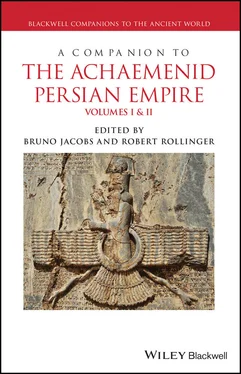The expedition against Miliṭia (modern Malatya), recalled in the annals (in CTU A 9‐1 rev.), was recorded on the rock (CTU A 9‐4) overlooking the Euphrates on the bank opposite to the Melitene. Beyond the Euphrates, in the region of Commagene (Assyrian Kummu  i, Urartian Quma
i, Urartian Quma  a), one of the greatest struggles between the Assyrians and the Urartians took place in 743 BCE (RlA s.v. Sarduri). The Annals of Tiglath‐Pileser III relate the Assyrian victory in the battle of Commagene, pushing the Urartians back to the east of the river which marked the western frontier of the Urartian kingdom (Tadmor 1994: pp. 100–101).
a), one of the greatest struggles between the Assyrians and the Urartians took place in 743 BCE (RlA s.v. Sarduri). The Annals of Tiglath‐Pileser III relate the Assyrian victory in the battle of Commagene, pushing the Urartians back to the east of the river which marked the western frontier of the Urartian kingdom (Tadmor 1994: pp. 100–101).
The Urartian expansion in Iranian Azerbaijan, toward the Caspian sea, is testified by the rock inscription (CTU A 9‐8) and the fortress of Seqendel (Kleiss and Kroll 1980), east of Tabriz, recording the conquest of the country of Puluadi and its capital city Libliuni together with many fortresses. In the Annals of Sarduri (CTU A 9‐3 D 8‐13) the same episode is narrated.
The War Between Rusa I and Sargon for the Control of Northwestern Iran
The Assyrian sources tell us that under Rusa I (c. 730–713 BCE), the contacts between Urartians and Mannaeans became more intense, and we can assume the existence of a direct influence of Urarṭu on the northern Mannaean territories: a kind of protectorate. The Mannaean prince Metatti of Zikirtu is presented as a vassal of king Rusa, and this situation soon led to a war with Assyria (Salvini in Pecorella and Salvini 1984: pp. 35–51).
During Rusa I's reign, west Azerbaijan was the center of important historical events (RlA s.v. Rusa). The three bilingual stelae erected by Rusa I on both sides of the Zagros range (CTU A 10‐3, 4, 5) show that the road along the western shore of the Urmia lake and through the pass of Kelišin was still the main access route of the Urartians through the Zagros to the city and temple of Muṣaṣir. The common text of those three documents tells us of the defeat of the local king Urzana, who had behaved like an enemy against Rusa, preventing him from entering  aldi's sanctuary.
aldi's sanctuary.
Rusa was at the height of his power: he had conquered the lands in Transcaucasia, at the expense of the tribes living beyond Lake Sevan (CTU A 10‐2). Moreover, he ruled a large part of the Mannaean territory and Muṣaṣir, even reaching the valley of the Lesser Habur river.
But Rusa's “days of joy” were suddenly interrupted by two political‐military catastrophes, which would be fatal to him. These are the Cimmerian invasion and Sargon's Eighth Campaign in 714 BCE (Thureau‐Dangin 1912). The relative chronology of the two events, as well as their “geography,” is controversial (one can read the different opinions in Biainili‐Urartu 2012).
The news of a military clash between Urar  u and the Cimmerians (Gimirra) appears in the letters of the Assyrian intelligence service. Some letters to king Sargon refer directly to this event, and they speak of the Urartian's defeat and losses. Other letters deal with the Urartian preparations for the expedition against the “land of Gimirra” (Lanfranchi and Parpola 1990).
u and the Cimmerians (Gimirra) appears in the letters of the Assyrian intelligence service. Some letters to king Sargon refer directly to this event, and they speak of the Urartian's defeat and losses. Other letters deal with the Urartian preparations for the expedition against the “land of Gimirra” (Lanfranchi and Parpola 1990).
The letter SAA V 145 (Deller in Pecorella and Salvini 1984: pp. 102–103. No 2.1) clearly says that the Cimmerians came “from the land of Mana,” that is from the southeast, not directly from the north, i.e. from the Caucasian mountains, as the traditional reconstruction maintains. I think that this episode took place not long before the Eighth Campaign, perhaps in 715 BCE.
The Last Century of the Urartian History
During the seventh century BCE the relations between Urarṭu and Assyria apparently became peaceful. Argišti II, successor to Rusa I, was concentrated in the northern territories, as we learn from his rock inscriptions in Azerbaijan and a stele in Armenia (CTU A 11‐3,4,5,6), and his son Rusa II excelled in the construction of beautiful fortified towns and residences like Karmir‐blur, Bastam, Kef Kalesi (literature by Zimansky 1998), Ayanis (Çilingiro  lu and Salvini 2001), and Toprakkale. The construction of Toprakkale (RlA s.v. Rusa
lu and Salvini 2001), and Toprakkale. The construction of Toprakkale (RlA s.v. Rusa  inili) was probably begun by Rusa II and completed by Rusa III, son of Erimena. He was the reformer of the Urartian state organization, introducing writing on clay tablets and bullae, unknown before, and the parallel use of a linear (hieroglyphic) script for administrative purposes. The excavation of his towns has restituted a great quantity of bronze objects, which is the most known achievement of the Urartians (Seidl 2004). Rusa III, son of Erimena, constructed the huge dams of the Rusa Lake (modern Keşiş Göl) for the irrigation of the plain of Van and the residence of Toprakkale (CTU A 14‐1,2). The succession of both homonymous kings is controversial (Seidl 2007; Salvini 2007), and the circumstances of the end of the Urartian kingdom are still obscure (different solutions are reflected in some contributions of Biainili‐Urartu 2012, especially by Ursula Seidl and Michael Roaf).
inili) was probably begun by Rusa II and completed by Rusa III, son of Erimena. He was the reformer of the Urartian state organization, introducing writing on clay tablets and bullae, unknown before, and the parallel use of a linear (hieroglyphic) script for administrative purposes. The excavation of his towns has restituted a great quantity of bronze objects, which is the most known achievement of the Urartians (Seidl 2004). Rusa III, son of Erimena, constructed the huge dams of the Rusa Lake (modern Keşiş Göl) for the irrigation of the plain of Van and the residence of Toprakkale (CTU A 14‐1,2). The succession of both homonymous kings is controversial (Seidl 2007; Salvini 2007), and the circumstances of the end of the Urartian kingdom are still obscure (different solutions are reflected in some contributions of Biainili‐Urartu 2012, especially by Ursula Seidl and Michael Roaf).
Robert Rollinger (2009), on the basis of a new reading of the Nabonidus Chronicle, maintains that Urarṭu was not destroyed by the Medes in the seventh century BCE but survived until the campaign of Cyrus in 547 BCE. It is possible that some form of state survived after the extinction of the written records, but it was no more the imperial power of the preceding centuries. A few decades later, with his equation Armina = Urašṭu, Darius testifies the presence of the new ethnic element, the Armenians, in the old Urartian territory. If we speak of political continuity, we have to stress that no one of the usurpers against whom Darius fought presents himself as the king of Urarṭu, and there is no reference to the old capital city of 瞈ušpa. However the name  aldita (Bisutun § 39) proves that at least the cult of the god of Muṣaṣir survived after the end of Urarṭu.
aldita (Bisutun § 39) proves that at least the cult of the god of Muṣaṣir survived after the end of Urarṭu.
The last mentions of Urar  u, in the Babylonian form Uraš
u, in the Babylonian form Uraš  u, refer to a geographical area more than to a policy. Nevertheless, some cultural influences could have entered the Achaemenid Empire. Besides the abovementioned elements we can find a precedent for the phenomenon of inscriptions written in the name of the ancestors, like those of Pasargadae (Schmitt 2009: CMa, CMb → DMc), written by Darius in the name of Cyrus, and of Genç Nameh, written by Xerxes (Schmitt 2009: p. 10) for his father Darius: the duplicate inscriptions of Išpuini's fortress in Zivistan (CTU A 2‐2A–E), south of Van, were certainly engraved in the second part of the reign of his son Minua (CTU IV pp. 321–322).
u, refer to a geographical area more than to a policy. Nevertheless, some cultural influences could have entered the Achaemenid Empire. Besides the abovementioned elements we can find a precedent for the phenomenon of inscriptions written in the name of the ancestors, like those of Pasargadae (Schmitt 2009: CMa, CMb → DMc), written by Darius in the name of Cyrus, and of Genç Nameh, written by Xerxes (Schmitt 2009: p. 10) for his father Darius: the duplicate inscriptions of Išpuini's fortress in Zivistan (CTU A 2‐2A–E), south of Van, were certainly engraved in the second part of the reign of his son Minua (CTU IV pp. 321–322).
| Assyrian kings |
Synchronisms (see Fuchs 2012) |
|
Urartian kings |
| Shalmaneser III (859–824 BCE) |
Quotes Ar(r)amu the Urartian (years 859, 856, 844 BCE) |
|
[no written records] |
|
|
|
[written records of:] |
| Shalmaneser III |
Quotes Seduri, the Urartian (year 832 BCE) |
= |
Sarduri I, son of Lutibri a(c. 840–830 BCE) |
| Shamshi‐Adad V (823–811 BCE) |
Quotes Ušpina (year 820 BCE) |
= |
Išpuini, son of Sarduri (c. 830–820 BCE) |
|
|
|
Co‐regency of Išpuini and Minua (c. 820–810 BCE) |
|
[no synchronism] |
|
Minua, son of Išpuini (c. 810–785/780 BCE) |
| Shalmaneser IV (781–772 BCE) |
Quotes Argištu/i (year 774 BCE) |
= |
Argišti I, son of Minua (785/78–756 BCE) |
| Ashur‐nirari V (754–745 BCE) |
Quoted by (year 754 BCE) |
|
Sarduri II, son of Argišti (756–c. 730 BCE) |
| Tiglath‐pileser III (744–727 BCE) |
Quotes Sarduri, Sardaurri (years 743, 735? BCE) |
= |
Sarduri II |
| Sargon (721–705 BCE) |
Quotes Ursā/Rusā (years 719–713) |
= |
Rusa I, son of Sarduri (c. 730–713 BCE) |
|
Quotes Argišta (year 709 BCE) |
= |
Argišti II, son of Rusa (713–? BCE) |
| Sennacherib (704–681 BCE) |
[no synchronism] |
|
|
| Esarhaddon (681–669 BCE) |
Quotes Ursā (year 673/672 BCE) |
= |
Rusa II, son of Argišti (first half of the seventh century BCE) |
|
|
|
|
|
|
|
Erimena ( LÚaṣuli?) b |
| Ashurbanipal (669–627 BCE) |
Quotes Rusā (year 652 BCE) c |
= |
Rusa III, son of Erimena |
| Ashurbanipal |
Quotes Ištar/Issar‐dūrī (year 646/642 BCE) |
= |
Sarduri III, son of Sarduri |
aNo written records of him.
Читать дальше

 i, Urartian Quma
i, Urartian Quma  aldi's sanctuary.
aldi's sanctuary. u and the Cimmerians (Gimirra) appears in the letters of the Assyrian intelligence service. Some letters to king Sargon refer directly to this event, and they speak of the Urartian's defeat and losses. Other letters deal with the Urartian preparations for the expedition against the “land of Gimirra” (Lanfranchi and Parpola 1990).
u and the Cimmerians (Gimirra) appears in the letters of the Assyrian intelligence service. Some letters to king Sargon refer directly to this event, and they speak of the Urartian's defeat and losses. Other letters deal with the Urartian preparations for the expedition against the “land of Gimirra” (Lanfranchi and Parpola 1990). lu and Salvini 2001), and Toprakkale. The construction of Toprakkale (RlA s.v. Rusa
lu and Salvini 2001), and Toprakkale. The construction of Toprakkale (RlA s.v. Rusa 










